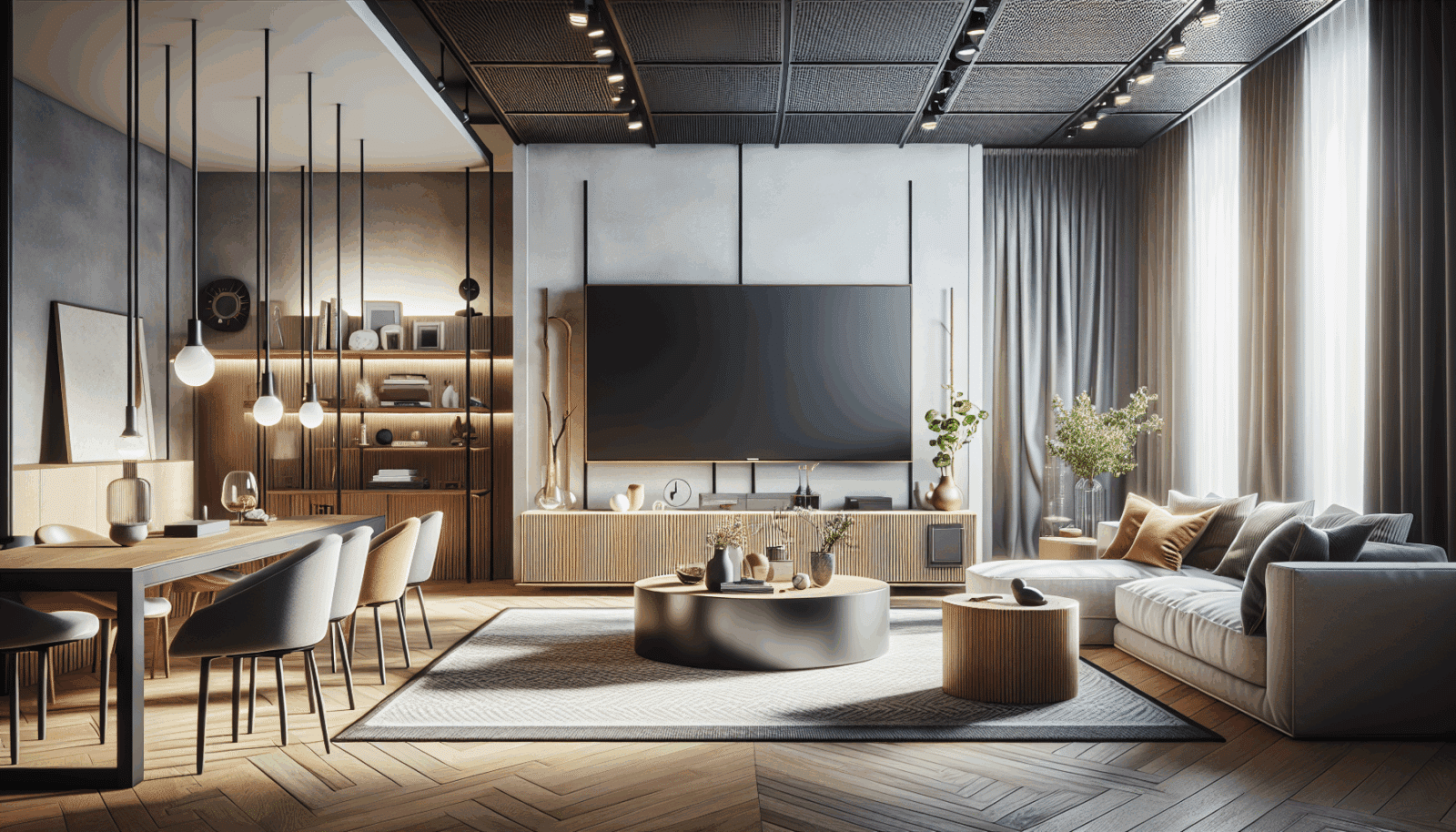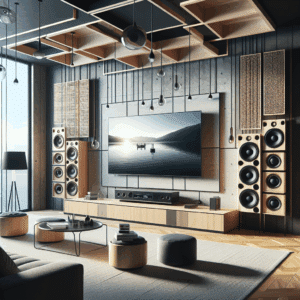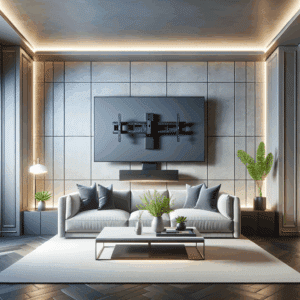At Utah TV Mounting, we understand that mounting a television in a unique space can be quite a challenge. Perhaps you’re dealing with an oddly shaped room or trying to create a viewing experience in an unconventional area. Worry not—we’re here to guide you through the process of mounting your TV seamlessly, no matter the space you have to work with. Our expertise extends beyond just Salt Lake, Davis, and Utah Counties, aiming to help homeowners everywhere who are scratching their heads about where to even start.
Contents
- 1 Understanding Your Space
- 2 Choosing the Right Mounting Bracket
- 3 Gathering Necessary Tools and Equipment
- 4 Locating Wall Studs Safely
- 5 Prepping the Wall
- 6 Drilling and Mounting
- 7 Adjusting for the Best Viewing Experience
- 8 Ensuring Wall Stability
- 9 Key Considerations for Unconventional Spaces
- 10 The Final Check
- 11 Conclusion
Understanding Your Space
Before you even think about drilling that first hole, it’s crucial to have a good understanding of your space. How large is the area? Are there any architectural features or odd angles? Answering these questions will help you determine the best type of mount to use. This section is all about knowing your environment. Consider factors like lighting and seating arrangements as these will influence where exactly the TV should be placed. Remember, the goal is to make the viewing experience as comfortable as possible.
Start by measuring the dimensions of the space. Write these figures down, as they’ll be incredibly useful when you find yourself standing in the hardware store wondering if that tilt-and-swivel model is really going to fit. Furthermore, consider whether the area gets direct sunlight—believe us, the last thing you want is a glaring reflection obscuring your shows.
Keep in mind the seating arrangement, too. The viewers’ comfort is paramount in determining the optimal height and angle for the mount. A rule of thumb: the center of the TV screen should naturally settle at eye level when you’re seated.
Choosing the Right Mounting Bracket
Selecting the right mounting bracket can feel overwhelming, given the myriad of choices out there. Do you need a fixed mount, or would a tilt-and-swivel option better suit your needs? It’s crucial to align your choice with your unique space features. Each type of mount has its pros and cons, and your decision should hinge on your immediate environment and viewing habits. For instance, a fixed mount is sleek and sits flush against the wall, perfect for unobstructed spaces where viewing angles are straightforward.
In contrast, an articulating mount offers the flexibility to adjust your TV for multiple viewpoints. This feature can be indispensable in more dynamic spaces like open-plan living areas. Essentially, it’s about reconciling the ergonomics of comfort with the aesthetics of your chosen room.
Consider ease of installation as well. Some mounts come with a hefty set of instructions that can confound even the savviest DIYer. Don’t hesitate to reach out to us for guidance or to handle the installation for you.
Gathering Necessary Tools and Equipment
Now that you’ve selected your mounting bracket, it’s time to gather the tools needed to complete the job. Think of this as assembling your own personal toolkit arsenal. Having everything on hand will streamline the process, ensuring that once you start, you won’t need to pause and search for that elusive screwdriver. You’ll typically need a drill, level, measuring tape, a stud finder, and a variety of screws and anchors that are likely included with your mount.
Your initial toolkit might seem rudimentary, but believe us when we say that those foundational pieces make all the difference. It’s wise to check out the mount’s specific instruction manual, as preferences might slightly vary and require additional tools.
We recommend reviewing the steps laid out ahead of time, ensuring you aren’t caught off guard by an unexpected twist mid-installation. Feel free to Contact Us if you find you’re missing a tool or are unsure of the exact requirements. We’re here to help!
Locating Wall Studs Safely
Finding a sturdy point to anchor your TV is key, which means you’ll need to locate wall studs safely. Generally, mistakes happen in this stage, so make sure to go about it methodically. By using a stud finder, you can easily locate the support beams behind your walls. This is crucial because mounting your TV with support from a stud ensures it can bear the weight over time.
Imagine hanging a heavy picture frame with a flimsy nail; eventually, gravity wins, and down it comes. By mounting your TV directly into a stud, you drastically reduce the chances of this happening. Once found, mark the stud location with a pencil, measuring to double-check precision never hurts.
If you’re dealing with a space where locating a stud seems impossible or there’s none to be found, fear not! There are drywall anchors available that can handle a reasonable weight as long as they’re chosen and installed correctly.
Prepping the Wall
Before you proceed with the actual installation, it’s important to prep the wall. This includes double-checking your measurements and mark placements. Consider cleaning the surface—believe it or not, dust can sometimes impact the adhesion of materials or even your perception of the measurements.
You may want to lightly sand the area to ensure a smooth spot for the mount to rest. Pay particular attention to areas that are textured or have older paint, as these can sometimes flake off and hinder the process.
Once satisfied with the location, lie down paper or a drop cloth. This will catch any dust or debris, and make cleanup a breeze once the installation is complete.
Drilling and Mounting
It’s time—the moment you’ve prepped for: drilling and mounting. Start by drilling pilot holes where you previously marked the wall studs. Don’t worry if this step feels daunting; drilling pilot holes ensures that you won’t accidentally split studs, creating a stronger foundation in the process.
Once your pilot holes are ready, attach the mount according to the specification with the included screws. Remember, it’s better to take this stage slow; adjustment on the fly can save both time and potential rework.
Align the mounting bracket perfectly before tightening your screws, it’ll ensure that everything sits flush and securely.
Adjusting for the Best Viewing Experience
Now that your TV is securely mounted, it’s time to fine-tune your setup for the best viewing experience. That might mean counteracting any glare or thinking about cable management. Viewing comfort is an art as much as a science—what works seamlessly for one setup might need minor tweaks for another.
To optimize, consider adjusting the tilt or angle of your TV depending on room dynamics and viewing habits. Don’t shy away from iterating on these tweaks until you achieve that “just right” feeling. It’s well worth the time to tailor your entertainment oasis.
Additionally, consider cable routing for a clean, polished look. Cord concealers or cable management boxes can be excellent investments that add to the overall aesthetic while keeping those pesky cords tidy.
Ensuring Wall Stability
Making sure the wall is stable enough is foundational for secure TV placement. If you ever have doubts about your wall’s integrity, consulting with structural guidelines or an expert can offer peace of mind. Every space is unique, which inherently means that some walls may not be initially ideal.
If you’re confronted with drywall or plaster, additional supports such as braces or dedicated wall anchor kits might be necessary. They enhance endurance while promising lasting support over time.
With the wall stabilized, the final touches can be added without concerns, letting you enjoy a stress-free viewing experience.
Key Considerations for Unconventional Spaces
Angled Walls: Sometimes, unconventional spaces can have walls that come at you from unexpected angles. Adjustable mounts with multiple pivot points are often your best choice, turning a quirky layout into a feature instead of a flaw. Corners: For corners, opting for a corner mount can maximize your viewing space while creating a unique area for entertainment. These mounts can bring the room to life by fusing functionality with style. Brick or Concrete Walls: These surfaces require specialized tools like concrete anchors to drill effectively. Otherwise, the mount might not secure firmly enough to trustably hold your TV’s weight. Outdoor Areas: Mounting a TV outdoors will require a weatherproof setup to withstand the elements. Special outdoor TV covers are available and are worth investing in to elongate the lifespan of your TV. Bedrooms: Opt for swivel mounts that offer flexibility as you watch TV while sitting up or lying down in bed. This ensures a comfortable line of sight wherever you are.
The Final Check
Finally, after taking all the necessary steps, a thorough check ensures that everything is sitting as it should. Different angles can help identify any tilting issues or loose segments that might need adjustment. Remember, the last thing you want is to return to this project a week later because something wasn’t quite perfect.
Take these final moments to complete an operational test. Ensure all ports are accessible and switch on the TV, taking note of the display alignment and whether any further changes are needed.
Your diligence will pay off, leaving you to relish in your perfectly installed, ready-to-use TV setup.
Conclusion
Mounting a TV in a unique space doesn’t have to be daunting. With our guide, you’re well-equipped to handle any challenge. For further assistance, contact us at 801-383-0493 or Request a Free Quote.




